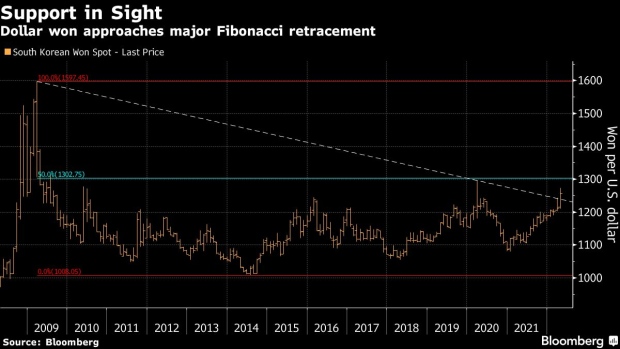May 1, 2022
Korean Won Poised for a Recovery After Worst Month in Five Years
, Bloomberg News

(Bloomberg) -- The South Korean won’s worst month since 2016 may be followed by a calmer spell as all signs point to a reprieve for now.
The currency is likely to rebound to a range of 1,220 to 1,230 per dollar after sliding to a two-year low of 1,273.95 last week, according to Kiwoom Securities Co. The biggest drags on its performance -- including a stronger dollar, dividend payments and China’s Covid curbs -- have already been priced in, says Stephen Lee, chief economist at Meritz Securities Co.
The won tumbled 3.5% last month as investors dumped riskier assets on fears that China’s lockdowns and quickening inflation may upend global growth. While a weaker currency is positive for South Korean exports, a rapid decline risks triggering capital outflows and destabilizing financial markets.
“The current dollar-won level is in the range we consider as overshooting,” said Kim Yumi, a market strategist at Kiwoom. “Instead of continuing to weaken, the won is expected to retrace some of its losses” once the uncertainties relating to Federal Reserve rate hikes and U.S. inflation data are past, she added.
The losses may have started to reverse. The South Korean currency rallied as much as 1.4% to 1,255.25 on Friday as the dollar slipped. The median forecast in a Bloomberg survey of analysts is for the won to strengthen to 1,200 by year-end.
Still, a lot will depend on what happens to the greenback in the coming months. Buoyed by bets for aggressive Fed rate hikes, the dollar may see its gains moderate if Treasury yields retreat or U.S. economic growth slows under the weight of policy tightening.
Analysts are also hopeful that the won will stabilize after South Korean firms completed the bulk of dividend payments in April. Corporates handed out at least 4.92 trillion won ($3.9 billion) of dividends to overseas investors last month, according to Bloomberg’s calculations based on company filings and data from the Korea Exchange.
Oversold Territory
Technicals indicate that the won is set to consolidate in the near term. Daily and monthly momentum indicators for the South Korean currency are in oversold territory, suggesting that the dollar-won pair’s rise above a descending trendline could be a false break.
April inflation data due Tuesday may also help stem the won’s losses. If official figures show consumer-price gains accelerated further from the 10-year high reached in March, this will back the case for more rate increases from the Bank of Korea to preserve the won’s yield advantage over the dollar.
Here are the key Asian economic data due this week:
- Monday, May 2: Manufacturing PMI from the Philippines, India, Taiwan and South Korea, Japan Jibun Bank manufacturing PMI, Japan vehicle sales and consumer confidence
- Tuesday, May 3: Hong Kong 1Q GDP, Thailand manufacturing PMI and business sentiment, South Korea CPI
- Wednesday, May 4: Indonesia manufacturing PMI, Singapore purchasing managers index
- Thursday, May 5: Hong Kong retail sales, Philippines CPI, Singapore retails sales, Thailand CPI, China Caixin services PMI, Malaysia manufacturing PMI
- Friday, May 6: Hong Kong foreign reserves, Philippines unemployment rate and trade data, Singapore Global PMI, Thailand foreign reserves, Taiwan CPI, South Korea foreign reserves, Tokyo CPI
©2022 Bloomberg L.P.





